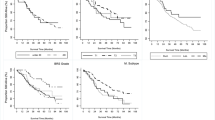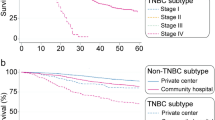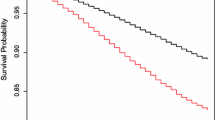Abstract
Background
Breast cancer incidence in sub-Saharan Africa (SSA) is increasing, and SSA has the highest age-standardized breast cancer mortality rate worldwide. However, high-quality breast cancer data are limited in SSA.
Materials and Methods
We examined breast cancer patient and tumor characteristics among women in Lilongwe, Malawi and evaluated risk factor associations with patient outcomes. We consecutively enrolled 100 women ≥ 18 years with newly diagnosed, pathologically confirmed breast cancer into a prospective longitudinal cohort with systematically assessed demographic data, HIV status, and clinical characteristics. Tumor subtypes were further determined by immunohistochemistry, overall survival (OS) was estimated using Kaplan–Meier methods, and hazards ratios (HR) were calculated by Cox proportional hazard analyses.
Results
Of the 100 participants, median age was 49 years, 19 were HIV-positive, and 75 presented with late stage (III/IV) disease. HER2-enriched and triple-negative/basal-like subtypes represented 17% and 25% tumors, respectively. One-year OS for the cohort was 74% (95% CI 62–83%). Multivariable analyses revealed mortality was associated with HIV (HR, 5.15; 95% CI 1.58–16.76; p = 0.006), stage IV disease (HR, 8.86; 95% CI 1.07–73.25; p = 0.043), and HER2-enriched (HR, 7.46; 95% CI 1.21–46.07; p = 0.031), and triple-negative subtypes (HR, 7.80; 95% CI 1.39–43.69; p = 0.020).
Conclusion
Late stage presentation, HER2-enriched and triple-negative subtypes, and HIV coinfection were overrepresented in our cohort relative to resource-rich settings and were associated with mortality. These findings highlight robust opportunities for population- and patient-level interventions across the entire cascade of care to improve breast cancer outcomes in low-income countries in SSA.



Similar content being viewed by others
References
Torre LA, Siegel RL, Ward EM, Jemal A (2016) Global cancer incidence and mortality rates and trends—an update. Cancer Epidemiol. Biomarkers Prev 25(1):16–27
Azubuike SO, Muirhead C, Hayes L, McNally R (2018) Rising global burden of breast cancer: the case of sub-Saharan Africa (with emphasis on Nigeria) and implications for regional development: a review. World J Surg Oncol 16(1):63
Bray F, Ferlay J, Soerjomataram I et al (2018) Global cancer statistics 2018: GLOBOCAN estimates of incidence and mortality worldwide for 36 cancers in 185 countries. CA Cancer J Clin 68:394–424. https://doi.org/10.3322/caac.21492
Der EM, Gyasi RK, Tettey Y et al (2015) Triple-negative breast cancer in Ghanaian women: the Korle Bu Teaching Hospital experience. Breast J. https://doi.org/10.1111/tbj.12527
McKenzie F, Zietsman A, Galukande M et al (2018) Drivers of advanced stage at breast cancer diagnosis in the multicountry African breast cancer—disparities in outcomes (ABC-DO) study. Int J Cancer. https://doi.org/10.1002/ijc.31187
Lukong KE, Ogunbolude Y, Kamdem JP (2017) Breast cancer in Africa: prevalence, treatment options, herbal medicines, and socioeconomic determinants. Breast Cancer Res Treat 166:351–365
Kohler RE, Gopal S, Miller AR et al (2017) A framework for improving early detection of breast cancer in sub-Saharan Africa: a qualitative study of help-seeking behaviors among Malawian women. Patient Educ Couns. https://doi.org/10.1016/j.pec.2016.08.012
Msyamboza KP, Dzamalala C, Mdokwe C et al (2012) Burden of cancer in Malawi; common types, incidence and trends: national population-based cancer registry. BMC Res Notes. https://doi.org/10.1186/1756-0500-5-149
The World Bank Group (2019) Malawi GDP per capita (US$), 2017. https://data.worldbank.org/indicator/NY.GDP.PCAP.CD?end=2017&locations=LR-BI-CF-MW&start=2014&view=chart%0A. Accessed 3 Jun 2019
Chasimpha SJD, Parkin DM, Masamba L, Dzamalala CP (2017) Three-year cancer incidence in Blantyre, Malawi (2008–2010). Int J cancer 141:694–700. https://doi.org/10.1002/ijc.30777
National Statistical Offce; Malawi Government (2018) 2018 Malawi population and housing census. Main report
UNAIDS (2019) HIV prevalence, Malawi, 2017. https://aidsinfo.unaids.org/. Accessed 3 Jun 2019
Hontelez JAC, de Vlas SJ, Baltussen R et al (2012) The impact of antiretroviral treatment on the age composition of the HIV epidemic in sub-Saharan Africa. AIDS 26(Suppl 1):S19–S30. https://doi.org/10.1097/QAD.0b013e3283558526
Oliver NT, Chiao EY (2017) Malignancies in women with HIV infection. Curr Opin HIV AIDS 12:69–76. https://doi.org/10.1097/COH.0000000000000332
Chirkut S (2019) Breast cancer, human immunodeficiency virus and highly active antiretroviral treatment; implications for a high-rate seropositive region. Oncol Rev 13:376. https://doi.org/10.4081/oncol.2019.376
Grover S, Martei YM, Puri P et al (2017) Breast cancer and HIV in Sub-Saharan Africa: a complex relationship. J Glob Oncol. https://doi.org/10.1200/JGO.2016.006585
Coghill AE, Shiels MS, Suneja G, Engels EA (2015) Elevated cancer-specific mortality among HIV-infected patients in the United States. J Clin Oncol 33:2376–2383. https://doi.org/10.1200/JCO.2014.59.5967
Pantanowitz L, Sen S, Crisi GM et al (2011) Spectrum of breast disease encountered in HIV-positive patients at a community teaching hospital. Breast. https://doi.org/10.1016/j.breast.2010.08.003
Pantanowitz L, Connolly JL (2002) Pathology of the breast associated with HIV/AIDS. Breast J. https://doi.org/10.1046/j.1524-4741.2002.08409.x
Sarhan M, Depaz HA, Oluwole SFD (2010) Breast cancer in women with human immunodeficiency virus infection: pathological, clinical, and prognostic implications. J Women’s Heal. https://doi.org/10.1089/jwh.2010.2026
Coghill AE, Newcomb PA, Madeleine MM et al (2013) Contribution of HIV infection to mortality among cancer patients in Uganda. AIDS 27:2933–2942. https://doi.org/10.1097/01.aids.0000433236.55937.cb
Gopal S, Krysiak R, Liomba NG et al (2013) Early experience after developing a pathology laboratory in Malawi, with emphasis on cancer diagnoses. PLoS ONE 8:e70361–e70361. https://doi.org/10.1371/journal.pone.0070361
Kohler RE, Miller AR, Gutnik L et al (2017) Experiences and perceptions regarding clinical breast exam screening by trained laywomen in Malawi. Cancer Causes Control. https://doi.org/10.1007/s10552-016-0844-0
Elston CW, Ellis IO (1991) Pathological prognostic factors in breast cancer. I. The value of histological grade in breast cancer: experience from a large study with long-term follow-up. Histopathology. https://doi.org/10.1111/j.1365-2559.1991.tb00229.x
Hammond MEH, Hayes DF, Dowsett M et al (2010) American Society of Clinical Oncology/College of American Pathologists guideline recommendations for immunohistochemical testing of estrogen and progesterone receptors in breast cancer. Arch Pathol Lab Med 134:907–922. https://doi.org/10.1043/1543-2165-134.6.907
Wolff AC, Hammond MEH, Schwartz JN et al (2006) American Society of Clinical Oncology/College of American Pathologists guideline recommendations for human epidermal growth factor receptor 2 testing in breast cancer. J Clin Oncol 25:118–145. https://doi.org/10.1200/JCO.2006.09.2775
NCCN (2017) NCCN harmonized guidelines for Sub-Saharan Africa. NCCN.org 2.2017:
Goldhirsch A, Winer EP, Coates AS et al (2013) Personalizing the treatment of women with early breast cancer: highlights of the st gallen international expert consensus on the primary therapy of early breast Cancer 2013. Ann Oncol. https://doi.org/10.1093/annonc/mdt303
Kroemer G, Senovilla L, Galluzzi L et al (2015) Natural and therapy-induced immunosurveillance in breast cancer. Nat Med 21:1128–1138. https://doi.org/10.1038/nm.3944
Gutnik L, Msosa V, Moses A et al (2016) Uptake and performance of clinical breast exam screening program by trained laywomen in Malawi. J Glob Oncol 2:45s–45s. https://doi.org/10.1200/JGO.2016.004051
Huo D, Ikpatt F, Khramtsov A et al (2009) Population differences in breast cancer: survey in indigenous African women reveals over-representation of triple-negative breast cancer. J Clin Oncol 27:4515–4521. https://doi.org/10.1200/JCO.2008.19.6873
Galukande M, Wabinga H, Mirembe F et al (2014) Molecular breast cancer subtypes prevalence in an indigenous Sub Saharan African population. Pan Afr Med J 17:249. https://doi.org/10.11604/pamj.2014.17.249.330
Adeloye D, Sowunmi OY, Jacobs W et al (2018) Estimating the incidence of breast cancer in Africa: a systematic review and meta-analysis. J Glob Health 8:10419. https://doi.org/10.7189/jogh.08.010419
Eng A, McCormack V, dos-Santos-Silva I (2014) Receptor-defined subtypes of breast cancer in indigenous populations in Africa: a systematic review and meta-analysis. PLoS Med 11:e1001720–e1001720. https://doi.org/10.1371/journal.pmed.1001720
Fallahpour S, Navaneelan T, De P, Borgo A (2017) Breast cancer survival by molecular subtype: a population-based analysis of cancer registry data. C open 5:E734–E739. https://doi.org/10.9778/cmajo.20170030
Blows FM, Driver KE, Schmidt MK et al (2010) Subtyping of breast cancer by immunohistochemistry to investigate a relationship between subtype and short and long term survival: a collaborative analysis of data for 10,159 cases from 12 studies. PLoS Med 7:e1000279–e1000279. https://doi.org/10.1371/journal.pmed.1000279
Howlader N, Altekruse SF, Li CI et al (2014) US incidence of breast cancer subtypes defined by joint hormone receptor and HER2 status. J Natl Cancer Inst. https://doi.org/10.1093/jnci/dju055
Jiagge E, Oppong JK, Bensenhaver J et al (2016) Breast cancer and African ancestry: lessons learned at the 10-year anniversary of the Ghana-Michigan research partnership and international breast registry. J Glob Oncol 2:302–310. https://doi.org/10.1200/JGO.2015.002881
Rugo HS, Barve A, Waller CF et al (2017) Effect of a proposed trastuzumab biosimilar compared with trastuzumab on overall response rate in patients with ERBB2 (HER2)-positive metastatic breast cancer: a randomized clinical trial. JAMA J Am Med Assoc. https://doi.org/10.1001/jama.2016.18305
Pivot X, Bondarenko I, Nowecki Z et al (2018) A phase III study comparing SB3 (a proposed trastuzumab biosimilar) and trastuzumab reference product in HER2-positive early breast cancer treated with neoadjuvant-adjuvant treatment: final safety, immunogenicity and survival results. Eur J Cancer. https://doi.org/10.1016/j.ejca.2018.01.072
Ohene-Yeboah M, Adjei E (2012) Breast cancer in Kumasi, Ghana. Ghana Med J 46:8–13
Dickens C, Joffe M, Jacobson J et al (2014) Stage at breast cancer diagnosis and distance from diagnostic hospital in a periurban setting: a South African public hospital case series of over 1,000 women. Int J cancer 135:2173–2182. https://doi.org/10.1002/ijc.28861
McCormack VA, Joffe M, van den Berg E et al (2013) Breast cancer receptor status and stage at diagnosis in over 1,200 consecutive public hospital patients in Soweto, South Africa: a case series. Breast Cancer Res 15:R84–R84. https://doi.org/10.1186/bcr3478
Ministry of Health (2016) Summary sheet preliminary findings: the Malawi population-based HIV impact assessment
Coghill AE, Engels EA, Schymura MJ et al (2018) Risk of breast, prostate, and colorectal cancer diagnoses among HIV-infected individuals in the United States. J Natl Cancer Inst 110:959–966. https://doi.org/10.1093/jnci/djy010
Sadigh K, Hodgeman R, Tapela N, et al (2019) HIV is associated with decreased breast cancer survival: a prospsctive cohort study. In: Conference on Retroviruses and Opportunistic Viruses. Seattle, p Abstract 16
Dryden-Peterson S, Medhin H, Kebabonye-Pusoentsi M et al (2015) Cancer incidence following expansion of HIV treatment in Botswana. PLoS ONE. https://doi.org/10.1371/journal.pone.0135602
Ochoa RE, Kyriakopoulos C, Hurley J (2012) Outcomes of 47 patients with human immunodeficiency virus infection treated for breast cancer: A 20-year experience. J Clin Oncol 30:1071. https://doi.org/10.1200/jco.2012.30.15_suppl.1071
Acknowledgments
We are grateful to patients, families, staff, and leadership at Kamuzu Central Hospital and UNC Project-Malawi for their support of this project.
Funding
This study was supported by (1) UJMT Fogarty Global Health Fellowship Program: D43TW009340; (2) Lineberger Comprehensive Cancer Center: P30CA016086; (3) UNC Breast Cancer Specialized Program of Research Excellence: P50CA058223; (4) Malawi Cancer Consortium and Regional Center of Excellence for NCDs: U54CA190152, P20CA210285; (5) Medical Education Partnership Initiative: R24TW008927; (6) UNC Center for AIDS Research: P30AI050410.
Author information
Authors and Affiliations
Corresponding authors
Ethics declarations
Conflict of interest
All authors declare that they have no conflict of interest.
Additional information
Publisher's Note
Springer Nature remains neutral with regard to jurisdictional claims in published maps and institutional affiliations.
Rights and permissions
About this article
Cite this article
Youngblood, V.M., Nyirenda, R., Nyasosela, R. et al. Outcomes and prognostic factors for women with breast cancer in Malawi. Cancer Causes Control 31, 393–402 (2020). https://doi.org/10.1007/s10552-020-01282-4
Received:
Accepted:
Published:
Issue Date:
DOI: https://doi.org/10.1007/s10552-020-01282-4




